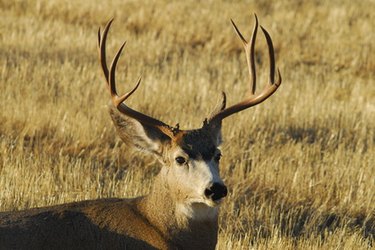Things You'll Need
Jeweler's saw
Hacksaw
Hydrogen peroxide
Pencil
Bucket
Wood-carving knives
Craft knife
Dremel
Sandpaper

Male deer, or bucks, naturally shed their antlers each year after the mating season is over. Interested carvers find these antlers lying on the ground in heavily wooded areas. According to Suwanee River Ranch, deer antlers are made of bone and not keratin. Carving a deer antler into a decorative pendant or knife handle is similar to the process of carving any other type of bone, but a few differences do exist.
Step 1
Soak the antler in a 3 percent to 9 percent solution of hydrogen peroxide and water. The University of Arizona Cooperative Extension recommends this step to bleach any marks or discoloration out of the antlers, and to remove the oils that can make carving more difficult. Sit the antlers in full sun until they are completely dry.
Video of the Day
Step 2
Saw off the part of the antler you wish to carve with a hacksaw. Wear the respirator while doing so to prevent inhalation of the bone dust, which leads to a lung infection. Use a jeweler's saw to make smaller and more detailed cuts.
Step 3
Draw the design onto the bone. A soft-leaded pencil will mark the antler easily, but can be erased if the design changes or a mistake is made during the drawing.
Step 4
Carve in the rough shape of the design, using a set of wood-carving knives. Antler carving enthusiast Mohawk also recommends using a craft knife. Craft knives are sharp enough to carve into the bone, and have replaceable blades that save time over having to sharpen dull carving knife edges.
Step 5
Smooth out sharp edges and carve finer details into the design, using a Dremel tool. A diamond or ruby burr will create a smooth finish on the antler's surface, and can carve the material quickly.
Step 6
Seal the antler with a thin coat of linseed oil. According to Dennis Walrod, author of "Antlers: A Guide To Collecting, Scoring, Mounting, And Carving", this will prevent the antler from cracking or peeling. The oil should be reapplied yearly, or more often if the antler is exposed to direct sunlight or rests on skin.
Tip
The design carved into the antler can be accented with ink or paint before sealing the piece.
Warning
Do not breathe in any of the dust produced while cutting or carving the antler. Wear a respirator while doing so to prevent inhalation of the bone dust, which leads to a lung infection.
Video of the Day